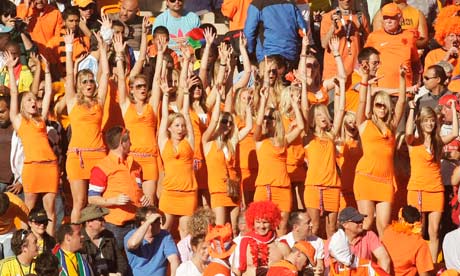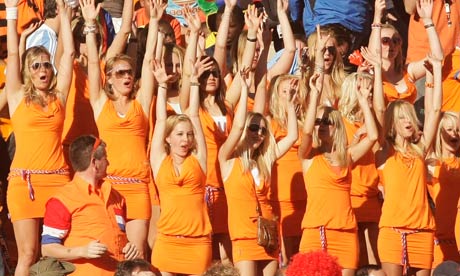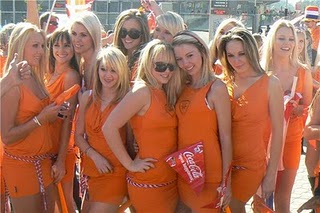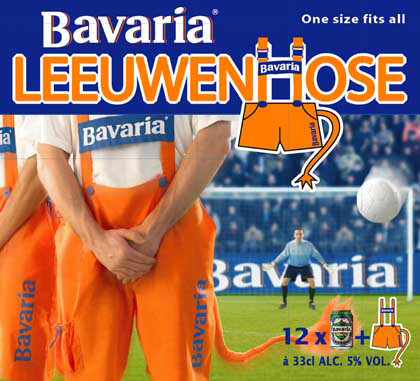
You may recall that during the last World Cup in 2006, The Dutch brewery brand Bavaria got themselves in hot wort by stealth marketing their brand during a match where fans wore orange lederhosen with the brewery’s logo on them, an item they sold online at the brewery’s website. I wrote about it then under the title Beer Marketing In Your Underwear? The official beer sponsor, Anheuser-Busch, got their lederhosen in a bunch because they were the “official” beer of the World Cup, ruffling more than a few feathers in Germany with it’s own rich beer history.
Fast forward four years to the World Cup in South Africa and nobody seems to have learned a damn thing from history, except perhaps the Bavaria Brewery. This year, during the match between the Netherlands and Denmark, 36 women were arrested for wearing plain orange dresses in a block of seats. I’m fairly certain it was indeed stealth marketing on the part of the brewery, but they broke no laws. There was no branding on the dresses and orange is the national color of Holland. Bavaria Beer has an entire Flickr gallery devoted to pictures of women wearing their plain orange dresses.

But FIFA stepped in to protect its revenue stream for the millions paid by Anheuser-Busch InBev to be the “official,” and more importantly exclusive, beer of the World Cup. The women were ejected from the game and “arrested under the Contravention of Merchandise Marks Act, which prevents companies benefiting from an event without paying for advertising.” FIFA in a statement said they “view ambush marketing in a very serious light” and called the act of wearing an orange dress an “illicit activity.” The police in South Africa have opened a “criminal investigation,” according to the UK’s newspaper, the Guardian.
But despite the rhetoric, they’re not exactly terrorists. They were all wearing plain orange dresses. Period. Arresting them gave the Bavaria beer brand more publicity than leaving them alone would have. And it does nothing to dispel the image of FIFA and ABIB as thugs who’ll do whatever they like to protect revenue streams above all else, human rights be damned.
As Pete Brown concludes in his own rant over this incident:
Let’s be realistic: even though Bavaria have denied involvement, of course it was a marketing stunt: why else would forty identically dressed women turn up in one block? But it’s a brilliant stunt: once again, Bavaria has had acres of free press coverage, and Fifa and Bud have been made to look really quite sinister and scary.
But that’s because they are. We all know it’s a marketing stunt, but it doesn’t break any rules. The rules prohibit competitive beer branding around the stadium. There was no branding. End of.
As the Bavaria spokesperson says, Fifa don’t have a trade mark on the colour orange. This is an astonishing abuse of human rights — admittedly a trivial one in the context of South Africa’s recent history, but still deeply disturbing, because it’s all about protecting the commercial rights of a beer brand. No brand should have the power to do something like this. If Fifa and Bud are to remain consistent in this policy, we should expect them to eject and detain any England fan with a St George’s cross flag, T-shirt or face paint, because this is a device used extensively in marketing by Bombardier, a competitive beer brand to Budweiser. That would be utterly absurd, outrageous and unacceptable of course. But then so is this.
How A-B InBev think this ugly, bullying behaviour helps enhance Budweiser’s reputation is beyond me.
I know it’s naive to think that any international sporting event should be just about the game, but I continue to hold out hope. But this is one more potent reminder of how the world really works. What Bavaria did may be technically against FIFA’s “policy” (which is very different from a “law”) yet they treated the policy-breakers like terrorists and used police powers essentially to carry out and punish people for breaking the rules of a corporation, reminding me chillingly of the way the military and police have been used to break up strikers. Money and power increasingly call the shots while human beings and small enterprise get trampled. I, for one, am going to start wearing a lot more orange.

UPDATE: A few more worthwhile articles about the incident have popped up. These include another Guardian piece, Another triumph for Fifa’s chillingly efficient rights protection team, by Marina Hyde, and Central State Asylum has a nice post from a legal standpoint. But perhaps most hilarious, someone has set up a Facebook page, I’ll buy Bavaria for the match to annoy FIFA.

UPDATE 6.19: Apparently the gals in orange did show up for the game versus Japan on June 19.







